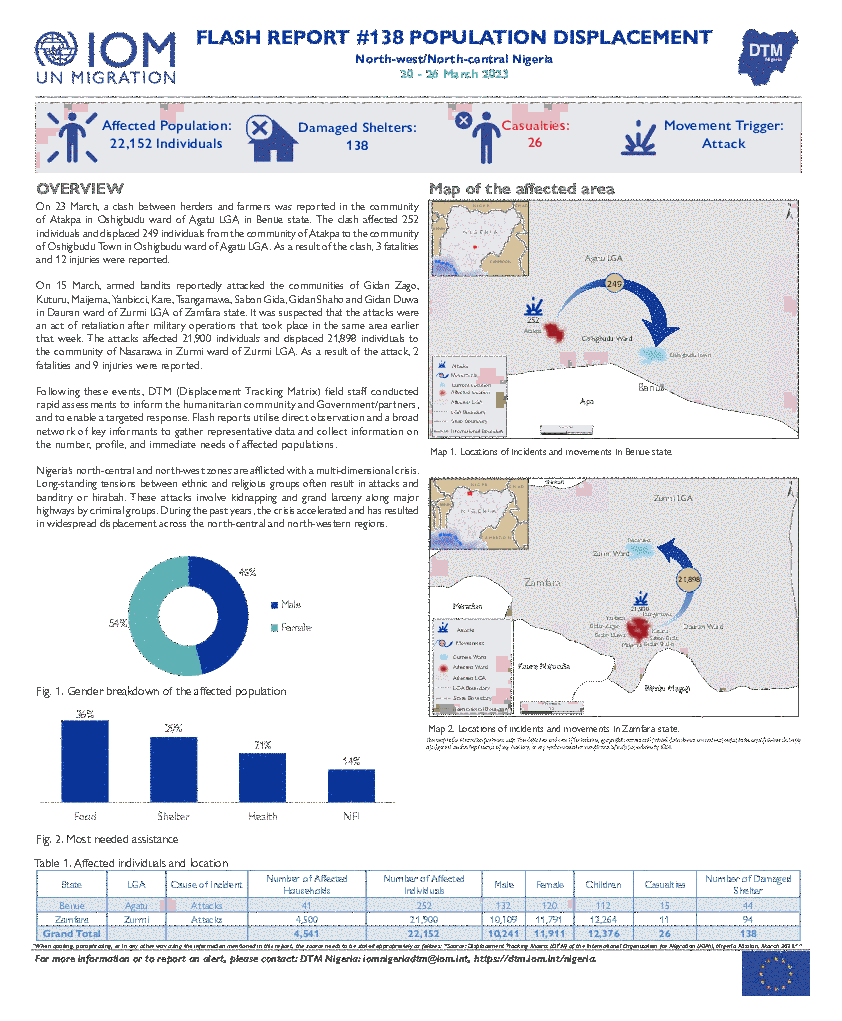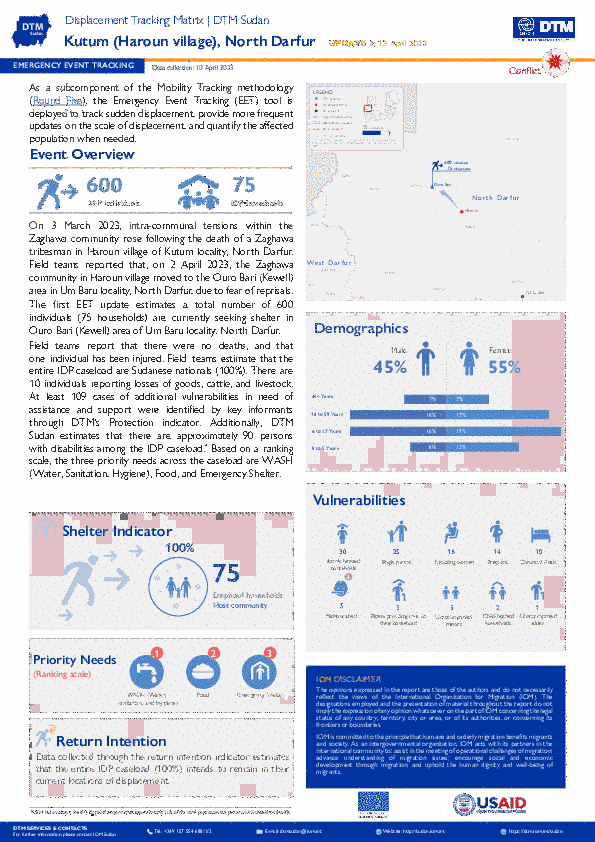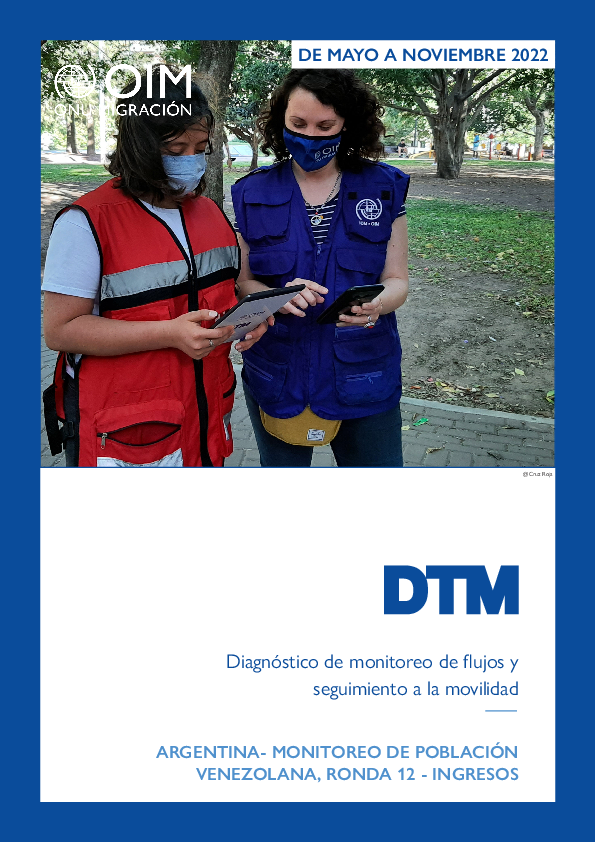-
Countries
-
Data and Analysis
-
Special Focus
-
Crisis Responses

Contact
DTM Nigeria, iomnigeriadtm@iom.int
Language
English
Location
Nigeria
Period Covered
Apr 03 2023
Apr 09 2023
Activity
- Mobility Tracking
- Event Tracking
The DTM Emergency Tracking Tool (ETT) is deployed to track and to collect information on large and sudden population movements, provide frequent updates on the scale of displacement and quantify the affected population when needed. As a sub-component of the Mobility Tracking methodology in Nigeria, ETT utilises direct observations and a broad network of key informants to capture best estimates of the affected population per location, enabling targeted humanitarian response planning.
Between 3 and 9 April 2023, a total of 959 new arrivals were recorded in locations in Adamawa and Borno states. The new arrivals were recorded at locations in Askira/Uba, Gwoza, Gubio, Damboa, Kala Balge* and Hawul Local Government Areas (LGAs) of the most conflict-affected State of Borno and in Gombi, Hong, Michika, Song, Mubi North, Yola South, Lamurde, Yola North and Fufore LGAs of Adamawa State.

Contact
DTM Nigeria, iomnigeriadtm@iom.int
Language
English
Location
Nigeria
Period Covered
Apr 03 2023
Apr 09 2023
Activity
- Mobility Tracking
- Event Tracking
On 05 April, clashes between herders and farmers were reported in the communities of Aila in Egba ward of Agatu LGA and Umogidi in Ugbokpo ward of Apa LGA. Both LGAs are situated in Benue State. These clashes affected 201 individuals and displaced 194 individuals to the communities of Egba in Egba ward of Agatu LGA and Government Secondary School Ogore in Ogore community of Ugbokpo ward in Apa LGA. As a result of the clashes, seven fatalities and 9 injuries were reported.
On 08 April, an attack was reported on Ngban IDP Camp in Nyiev ward of Guma LGA in Benue State. An estimated 248 individuals were affected by the violence, and 204 were displaced to Ortessy IDP Camp in Nyiev ward. As a result of the attack, 88 fatalities and 35 injuries were reported.

Contact
DTM Nigeria, iomnigeriadtm@iom.int
Language
English
Location
Nigeria
Period Covered
Mar 27 2023
Apr 02 2023
Activity
- Mobility Tracking
- Event Tracking
On 27 March, armed bandits reportedly attacked the communities of Bugai, Awaro, Dagara, Rema, Tashar Keji, Dagara II and Ungwan Malam Shehu in Magajin Gari ward of Birnin Gwari LGA of Kaduna state. These attacks affected 4,264 individuals and displaced 4,186 individuals to Bagoma community which is approximately 12 km south. During the incident, about 72 individuals were abducted. The displaced are currently hosted in Bagoma Primary School, neighbouring houses and nearby communities in the Bagoma community. As a result of the attacks, six fatalities and 13 injuries were reported.

Contact
DTM Nigeria, iomnigeriadtm@iom.int
Language
English
Location
Nigeria
Period Covered
Mar 20 2023
Mar 26 2023
Activity
- Mobility Tracking
- Event Tracking
On 23 March, a clash between herders and farmers was reported in the community of Atakpa in Oshigbudu ward of Agatu LGA in Benue state. The clash affected 252 individuals and displaced 249 individuals from the community of Atakpa to the community of Oshigbudu Town in Oshigbudu ward of Agatu LGA. As a result of the clash, 3 fatalities and 12 injuries were reported.
On 15 March, armed bandits reportedly attacked the communities of Gidan Zago, Kuturu, Maijema, Yanbicci, Kare, Tsangamawa, Sabon Gida, Gidan Shaho and Gidan Duwa in Dauran ward of Zurmi LGA of Zamfara state. It was suspected that the attacks were an act of retaliation after military operations that took place in the same area earlier that week. The attacks affected 21,900 individuals and displaced 21,898 individuals to the community of Nasarawa in Zurmi ward of Zurmi LGA. As a result of the attack, 2 fatalities and 9 injuries were reported.

Contact
dtmhaiti@iom.int
Language
English
Location
Haiti
Period Covered
Apr 07 2023
Apr 11 2023
Activity
- Mobility Tracking
- Event Tracking
The objective of the Emergency Tracking Tool (ETT) is to collect information on large and sudden population movements as well as security and climatic emergencies. Information is collected through phone interviews with key informants and direct observation. This dashboard presents information on population displacement which occurred since 7 April 2023 in the ONA-Ville neighborhood located in the municipality of Thomazeau (West district), following armed attacks
This neighborhood, located in the 4eme Section des crochus in the municipality of Thomazeau (West district), has faced attacks of armed individuals as of 7 April 2023. In addition to loss of life, burning and looting of houses, these attacks have also caused the displacement of approximatively 1,226 individuals (279 households) who took refuge in many neighborhoods in different municipalities of the West district : Thomazeau (41% of displaced persons took refuge in locations of this municipality), Croix-des-Bouquets (27%), Tabarre (21%), Delmas (7%) and Cité Soleil (4%). A little over half of displaced persons are hosted in host communities (51%) while the remaining 49 per cent are hosted in 3 spontaneous sites including 2 newly ones created by this displacement wave (Ecole Lumane Casimir and Eglise Wesleynne) and one site which existed since 2022 (Place Cercine).

Contact
DTM Sudan; dtmsudan@iom.int
Language
English
Location
Sudan
Snapshot Date
Apr 10 2023
Activity
- Mobility Tracking
- Event Tracking
The DTM Emergency Event Tracking (EET) is deployed to track sudden displacement and population movements, provide more frequent updates on the scale of displacement, and quantify the affected population when needed. As a subcomponent of the new Mobility Tracking methodology in Sudan (Round Five), and activated on a need basis, EET utilises a broad network of key informants to capture best estimates of the affected population presence per location – a useful tool for humanitarian response planning and design.

Contact
DTM Sudan; dtmsudan@iom.int
Language
English
Location
Sudan
Snapshot Date
Apr 10 2023
Activity
- Mobility Tracking
- Event Tracking
The DTM Emergency Event Tracking (EET) is deployed to track sudden displacement and population movements, provide more frequent updates on the scale of displacement, and quantify the affected population when needed. As a subcomponent of the new Mobility Tracking methodology in Sudan (Round Five), and activated on a need basis, EET utilises a broad network of key informants to capture best estimates of the affected population presence per location – a useful tool for humanitarian response planning and design.

Contact
iombuenosaires@iom.int
Language
Spanish
Location
Argentina
Period Covered
Oct 01 2022
Dec 31 2022
Activity
- Survey
- Flow Monitoring Survey
Actualmente, se estima que aproximadamente 7.1 millones de personas de nacionalidad
venezolana residen fuera de la República Bolivariana de Venezuela , de las cuales 5.9 millones
residen en países de América Latina y el Caribe. En la República Argentina, residen más
de 200.000 personas venezolanas, siendo este flujo poblacional uno de los más dinámicos
en años recientes en un país históricamente receptor de inmigración. La magnitud de este
movimiento de población resulta inédita en la historia reciente de América Latina y el
Caribe e involucra tanto a refugiados como migrantes de aquel país.
La experiencia demuestra que los movimientos poblacionales a gran escala persisten y se
complejizan en ausencia de soluciones políticas y solidaridad internacional continua. Dada
la magnitud de la salida de personas venezolanas, solo un enfoque integral y coordinado a
nivel regional entre los gobiernos, con el apoyo de la comunidad internacional, permitirá a
la región hacer frente a la magnitud de este influjo.
Con este objetivo en mente, el Plan Regional de Respuesta para Refugiados y Migrantes
Venezolanos (RMRP, por sus siglas en inglés) se ha desarrollado para apoyar y complementar
la labor de las autoridades nacionales de América Latina y el Caribe, respondiendo a las
necesidades de la población de manera integral y exhaustiva y en el marco de los mecanismos
regionales de respuesta y coordinación.
Desde 2018 OIM Argentina ha implementado la Matriz de Seguimiento del Desplazamiento
(DTM, por sus siglas en inglés) en su modalidad de Encuesta de Monitoreo de Flujos (en
diversos puntos de ingreso al territorio nacional y de estancia).
La DTM es un sistema para monitorear movimientos de población y cuenta con una variedad
de herramientas de medición. Cada una de ellas puede ser adaptada para dar seguimiento
de forma sistemática y regular al desplazamiento de personas en diversos contextos. Su
objetivo principal consiste en conocer el perfil y mejorar la comprensión de las necesidades
de la población que se moviliza en diferentes situaciones.
Desde 2018, la implementación de la DTM en la República Argentina ha tenido como
objetivos: caracterizar a la población venezolana que arriba o que reside en el país, para
conocer sus aspectos sociodemográficos, las rutas recorridas, su situación migratoria,
laboral, sus posibilidades de acceso a la salud, a los alimentos, a la vivienda y a la información.
También se indaga acerca de las necesidades concretas de asistencia y sobre los procesos
de reunificación familiar que las personas encuestadas consideran experimentarán en el
corto o mediano plazo.
La DTM ronda 13 se realizó durante los meses de octubre, noviembre y diciembre de 2022.
Las encuestas se aplicaron en la Ciudad Autónoma de Buenos Aires, Provincia de Buenos
Aires (La Plata, Moreno, Vicente López y Mar del Plata), Córdoba, Mendoza (Mendoza y San
Rafael), y Santa Fe (Rosario).

Contact
iombuenosaires@iom.int
Language
Spanish
Location
Argentina
Period Covered
May 20 2022
Nov 03 2022
Activity
- Survey
- Flow Monitoring Survey
En la actualidad se estima que aproximadamente 7.1 millones de personas de nacionalidad
venezolana residen fuera de la República Bolivariana de Venezuela , de las cuales 5.9 millones
residen en países de América Latina y el Caribe. En la República Argentina, se estima que
residen más de 200.000 personas venezolanas, siendo este flujo poblacional uno de los más
dinámicos en años recientes en un país históricamente receptor de inmigración.
Los flujos de personas refugiadas y migrantes venezolanas revisten especial interés, dado
que presentan necesidades específicas que los distinguen de otros grupos de inmigrantes de
la región. Se trata de movimientos a gran escala, sostenidos en el tiempo, que requieren de
soluciones políticas y solidaridad internacional. Con el fin de garantizar un enfoque integral
y coordinado a nivel regional entre los gobiernos, actores de sociedad civil y la comunidad
internacional, surge la Plataforma Regional de Coordinación Interagencial que fue creada en
conformidad con la solicitud del Secretario General de las Naciones Unidas al ACNUR y
la OIM el 12 de abril de 2018, para dirigir y coordinar la respuesta a los/as refugiados/as y
migrantes de Venezuela.
En este marco se crea la Plataforma Nacional de Respuesta para Refugiados y Migrantes de
Venezuela en la República Argentina que actualmente forma parte del capítulo subregional
Cono Sur incluido en la Plataforma Regional. A su vez, OIM Argentina es co-líder del Sector
de Manejo de Información de la Plataforma Nacional, que se encarga de aunar esfuerzos
para brindar asistencia en materia de manejo de información al equipo de coordinación.
La Matriz de Seguimiento del Desplazamiento (DTM por sus siglas en inglés), en tanto
herramienta desarrollada por OIM en situaciones de emergencia, reviste un instrumento
fundamental a la hora de proveer información sobre el perfil y las necesidades de la
población venezolana. Desde 2018 se han implementado 11 rondas de Monitoreo de Flujo
y de Encuesta en lugares de residencia, con la finalidad de mejorar las acciones destinadas
a este grupo. En el informe a continuación se presentan los resultados de la Ronda 12,
realizada entre el 20 de mayo y el 3 de noviembre de 2022, que tuvo entre sus objetivos
caracterizar a la población venezolana que ingresa al país por vías terrestres y brindar
información sobre rutas migratorias, características de su viaje, necesidades de asistencia,
impacto de la COVID-19 y reunificación familiar.
Esta Ronda de la DTM ha sido financiada con fondos del Bureau of Population, Refugees and
Migration (PRM), del Gobierno de Estados Unidos de América.

Contact
DTM Haiti, DTMHaiti@iom.int
Language
English
Location
Haiti
Period Covered
Feb 12 2023
Mar 16 2023
Activity
- Mobility Tracking
- Site Assessment
- Baseline Assessment
In recent years, widespread insecurity in the Port-Au-Prince Metropolitan Area (PAPMA) has led to the displacement of thousands of people. In order to regularly update authorities and other partners on the displacement situation in PAPMA and therefore inform response strategies for displaced persons and communities hosting them, the Haitian Directorate General for Civil Protection (DGPC) and the International Organization for Migration’s Displacement Tracking Matrix (DTM) launched in August 2022, periodic assessments of neighborhoods and sites hosting displaced populations. Data is collected through direct observations and interviews with key informants in the areas hosting displaced populations. Two updating exercises (rounds) have been conducted : Round 1 was conducted from June to August 2022, and Round 2 was conducted from October to November 2022.
This dashboard presents the key findings from the third updating exercise (Round 3), conducted between 14 February and 16 March 2023. Of the 429 neighborhoods in the PAPMA, 411 were assessed, representing a coverage of 96 percent. A total of 127,977 Internally Displaced Persons (IDPs) (28,415 households) were identified, of which 38 percent were living in spontaneous-sites and 62 percent in host communities. Compared to Round 2, overall, there was a decrease of 18 per cent in the number of IDPs, which can be explained by the fact that some IDPs have returned to their origins. Indeed, 45,864 returnees (former IDPs) were identified, of which 32 percent returned between the last quarter of 2022 and the first quarter of 2023